B
| Bairds of Auchmedden, Recumbent Figure Tomb |
|---|

A fine recumbent figure tomb set in a gabled enclosure, the Medieval meets the Renaissance in a particularly Scots idiom. There is an interesting central motif below the figure of corn springing from bones. The wild boar in the crest is extremely rotund and has something almost oriental in its design. Inscriptions: (motto at top) Dominus fecit. (main plaque) An. Dom. 1636. Positum a Georgio Baird de Aucbmedden praeposito Burgi de Bamff in honors Dei & in memorii praedicessoru quorum corpora in die resurrectionis . hic sepulta jacent.(underneath with memento mori) G. B. Mors sceptra ligonibus aequans. Spes altera vitae. Coelum non solvm quaero. More Information |
| Battle of Corrichie, Memorial |

A roughly cut granite menhir with an inscription cut in relief. The Gaelic inscription reads: "Cuimhnichibh La Coire Fraoichidh" or "Remember the day of Corrichie". The battlefield is now mainly covered by commercial forest. More Information |
| Bishop Meldrum Marnoch |
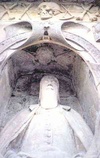
A baroque extravaganza of a tomb. More Information |
C
| Castle Street War Memorial |
|---|

Listed Category B. Polished pale grey granite ashlar cenotaph, standing on shallow steps in shallow hemicycle wall Plaques recording the names of the fallen,1914-19 and 1939-45 set in the outer ends of the hemicycle, the chequered granite blocks with voids reveal glimpses of Banff. The foundation stone for the War memorial was laid by HRH Princess Royal, 27th May 1921. More Information |
| Culsh Monument |
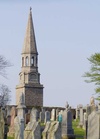
The 80ft (24m) Culsh Monument, erected 1876 in memory of William Fordyce MP of Brucklay , Aberdeenshire's first MP. |
D
| Duff House Dogs Gravestones |
|---|

Gravestone erected by the Earl of Fife, in memory of families pet dogs Bevis (1872) , Tip (1873) and Barkis. Decorated with crown and coronet with dog's names and initials M and F (male / female?). More Information |
| Duff House Mausoleum |

Rectangular Gothic Mausoleum and re-sited late 17th Century tomb. Fine cast and wrought iron gate incorporating complex designs of foliage, anthemion, rosettes, Earl of Fife's coronet and monogram JF. Deep stone frieze below eaves, 2 Coade stone crocketed pinnacles survive. Re-sited against centre of S elevation is a round headed figure tomb, decorated with symbols of mortality and rebirth. The tomb was supposed to be that of Robert the Bruce and was taken to give spurious antiquity to the new Earldom of Fife, however it was actually the tomb of Provost Douglas of Banff, with the inscription covered until in 1990 when it slipped uncovering the true identity. House open to the public. See their website for details. More Information |
E
| Electra, Bodie Enclosure, Head on Pillow Stone |
|---|
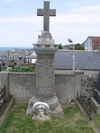
Carved pillow stone erected in memory of Isabella Henry or "La Belle Electra" assistant to Dr Walford Bodie. More Information |
F
| Fettercairn the Royal Arch |
|---|

A triumphal arch of Rhenish Romanesque style; round arch between two high buttressed octagonal towers with short gabletted spirelets and wrought-iron finials. The top of the arch is finished with a crenellated parapet with a curvilinear gablet feature at the centre. It was the winner of a competition, assessed by Queen Victoria, to commemorate a visit by Victoria and Albert in 1861. More Information |
G
| Gravestone with death figure, St Marys Graveyard, Banff |
|---|
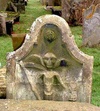
Gravestone carved in high relief with a winged 'grim reaper' death figure, with a scythe and hourglass. More Information |
| Gravestones, St. Brandons Kirk Cemetry Boyndie |
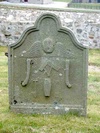
Located at side of narrow road, no parking facility. The stones include: |
I
| Innes/Russel enclosure, St Marys Graveyard, Banff |
|---|

A very geometric neo-classical almost Egyptianate monument. |
K
| Knowes War Memorial |
|---|

Category B listed Dominating the skyline in Macduff, the Knowes War Memorial stands 70 ft in height, an octagonal granite tower, erected in 1921 to commemorate those who gave their lives in the The Great War, 1914-1918. |
M
| Madonna, Banff |
|---|
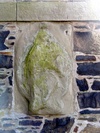
2 Panels depicting Virgin and Child, first datestone 1628, second much weathered possibly pre 1600's. More Information |
| Meethill monument - Reform tower Peterhead |
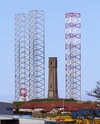
A tall tapering five storey tower, Greek cross in section, with a crenellated parapet corbelled out over the remainder. |
| Millennium |

Unusually for the artist, Frank Bruce, this is a large stone carving. Made to celebrate the 2000 millenium. More Information |
| Mystic Marie |
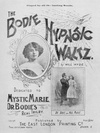
Grave of Mary Walford Henry, or "Mystic Marie" assistant to Walford Bodie ("Dr" Walford Bodie, billed as "Electrical Wizard of the North," a show business personality with national reputation.). Upright dark grey/black polished granite tombstone with carved marble angel figure erected on top, also has portrait bronze plaque in the same style as Bodie Fountain. |
N
| New Aberdour Millennium Memorial |
|---|
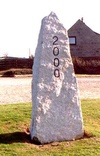
A minimalist monument consisting of a menhir of undressed granite, inscribed with the numerals 2000, recalling the megaliths of prehistory. More Information |
| New Pitsligo Millennium Memorial |
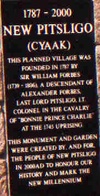
A monument consisting of a simple pillar of dressed granite, topped by a granite pyramid on a pedestal of coursed granite rubble with part dressed corners, in a formal setting of paving and planting with commemorative wooden benches. In the recent past New Pitsligo was noted for its granite quarries, all now closed, and was home to many masons and stonecutters. The form of this monument with its reused stone recalls this aspect of local history. |
O
| Ogilvie Tomb, Fordyce |
|---|
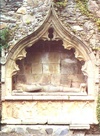
Magnificantly carved ogee-arched altar tomb of the Ogilvies of Findlater. |
P
| Patrick Gordons Cairn |
|---|
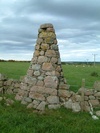
An elegant elongated cone shaped cairn with in-curved sides in coursed dry stone, without any interpretative sign. It is on the lands of Auchleuchries that Patrick Gordon belonged to. More Information |
| Prince Albert Cairn |

A monumental pyramid of cut granite stones More Information |
| Prince Arthurs cairn |
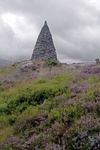
A cone of coursed rubble More Information |
| Prince Leopolds Cairn |

A stout cone of coursed granite rubble More Information |
| Princess Alices cairn |

A cone of coursed rubble. The inscriptio reads: Prince Louis of Hesse D'Armstadj - The Princess Alice of England - Married 1st July 1862 More Information |
| Princess Beatrices cairn |
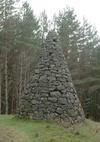
A cone of coursed granite rubble More Information |
| Princess Helenas cairn |

A cone of coursed granite rubble More Information |
| Princess Louises cairn |

Cone of coursed granite rubble. The inscription reads: HRH the Princess Louise of England- The most noble The Marquis of Lorne-Married the 21st March 1871 More Information |
| Princess Royals cairn |
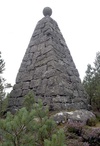
A four sided obelisk of roughly dressed granite stones surmounted by an orb More Information |
| Prop of Ythsie |

A bit of an ugly and intimidating monument to the hereditary principle and the divine right of the aristocracy/rich to rule the rest of us for their own advantage, however it is worth the climb up both the hill and the stairs for the view toward Bennachie. Erected to the memory of the Prime Minister the Fourth Earl of Aberdeen. A square tower of coursed red granite with dressed quoins and a corbelled and crenellated parapet. The lower stage is steeply battered. SMR More Information |
| Purchase Cairn |
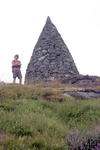
Cone of coursed granite rubble More Information |
R
| R.A.F. Banff Strike Wing Memorial |
|---|

The inscription reads: |
| Reform Monument |

Monument; erected in 1833 , it was erected by local ‘Tories’ (Conservatives) on the site of the market cross to celebrate Parliamentary reform. A Roman Doric column surmounted by the arms of the Earl Marischal with a lion above; this coat of arms was originally in a gateway to Inverugie castle, recently restored. |
S
| SANDS headstone |
|---|
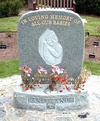
Headstone erected by local branch of SANDS organisation (SANDS Stillbirth And Neonatal Death Society) and set in a small garden of remembrance, in memory of local children who died at birth or in infancy. Polished grey granite stone engraved with baby cradled in a hand. More Information |
| St James the Great, Episcopal Church Stonehaven, pulpit |

Decoratively carved Caen stone pulpit designed by Arthur Clyne, built under the supervision of sculptor James Bremner of Broughty Ferry, incorporating quatrefoil panels with carved heads of (according to the Listed Building Record): St. James, King David of Scotland 1124-1153, Bishop Forbes, Bishop Keith and Bishop Jolly bishop of Moray 1798-1838. This above information is contradicted by the information given in the church and Booklet on the history of St. James Church, available in the church, this lists the heads on the pulpit as: St Ninian (of Candidacasa aka Whitehouse) 397-432, St David King of Scotland 1124-1153, John Sinclair bishop of Brechin 1565-66, Alexander Jolly bishop of Moray 1798-1838, and Alexander Penrose Forbes bishop of Brechin 1847-75 (my own view based on the clothing/facial hair, much more like a Victorian interpretation of Middle Eastern clothing than Brythonic Celtic, is that the LBR is right about the first head being intended as St. James). Carved with the quote "heaven and earth shall pass away but my words will not pass away". The green marble balls at the angle of the panels above and below come from Egypt and the red from Victoria in South Africa. More Information |
| St. Marys Graveyard, Renaissance style enclosure |

Renaissance style memorial complete with Corinthian columns and trumpeting angels. The relief lettering is badly eroded and now mostly illegible. However it is given in Annals of Banff list of inscriptions (see external link) as |
| Statue of Marshall Keith |
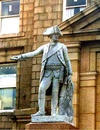
1869. August 16th Marshal Keith monument unveiled by the Earl of Kintore. |
| Stone Head, Colleonard |

A small stone sculpture by Frank Bruce. More Information |
T
| The Mans the Gowd, Colleonard |
|---|

A large symbolic wood carving by Frank Bruce More Information |
| The Port Arch, Port Elphinstone |

The two arches of this bronze symbolise the bridges over the River Don and the Aberdeenshire Canal since it is because of these that Port Elphinstone (that part of the settlement on the South bank of the Don) came into being. The plinth section represents standing stones, The spaces between the three sections of the granite base represent the river and the canal. The symbols in the top surface were designed and executed together with children from Port Elphinstone school and represent episodes from the history of the town. More Information |
| Thomas Edwards Gravestone |
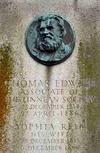
A Bronze plaque portrait on the gravestone of Thomas Edwards, a local naturalist and member of the Linean Society. More Information |
| Tomb of George Baird of Auchmeddan, Old Aberdour |

A 16th century grave slab relocated to the wall of the ruined St Drostan's More Information |
U
| Unknown Marnoch |
|---|

Neo Classical style tomb. More Information |
V
| Various items at Old St.Cyrus cemetry |
|---|
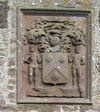
Reputed to be the site of a 13th - century kirk, there was said to be no visible signs of its position within the yard though a four-sided structure is present to the rear of the site bearing a carved stone lintel and chamfer-edged doorway. This enclosure, is said to be a burial ground. Built into a corner of the kirkyard is a small old watch-house with a good secure door and a small watch window. |
This content was submitted by external contributors and does not necessarily reflect the views of the University of Aberdeen.
